Over the past year, in the wake of calls for energy savings, LED lamps have gained great popularity. In this article, we decided to look at their application not only with practical side, but also from the point of view of user comfort and safety of their use for health.
A short excursion into history or what kind of lamps are
Initially, the ball was ruled by ordinary incandescent lamps, emitting in the visible range about 20-25% of the consumed energy. The spectrum of such lamps is as close as possible to warm sunlight, however, there is a bias towards redness, and the temperature luminous flux usually at a level of 2000-3000 K.
They were replaced by fluorescent lamps, a subspecies of which are now popular "housekeepers" - the same fluorescent bulbs, twisted into bizarre shapes and working in conjunction with EPRU, which increased their efficiency by about 10-20% in comparison with conventional lamps daylight... Their radiation spectrum is colder - about 3000-6000K and higher (do not be surprised, the higher the temperature, the colder light, such a paradox), and the efficiency reaches 50-60% or more. By the way, more than three billion such lamps are produced in the world per year, which is a lot.
The latest developments of engineers are light emitting diodes. They are almost an order of magnitude more effective. fluorescent lamps, are much more compact and have a relatively longer service life. However, the spectrum of such lamps is shifted towards blue and green tones, which, to put it mildly, is unnatural lighting for humans. The temperature of the emitted flux can easily vary over a wide range, from hundreds to thousands of K by changing the composition of the crystal.
LED lamps - advantages and disadvantages
But, despite the listed advantages: efficiency, compactness, the presence of a rich selection of colors and glow temperatures - LED lamps have serious disadvantages.
- High price. Now a luminaire with a set of LED lamps costs, if not an order of magnitude, then at least several times more expensive than a similar in power, but equipped with fluorescent lamps.
- The service life often does not correspond to the calculated one, usually the manufacturer gives a 3-5 year warranty. The situation is aggravated by the fact that without proper cooling, the diode crystals quickly degrade and the lamp fails.
- The lighting spectrum of most budget lamps usually causes discomfort for most people due to unnaturalness. The physical feature of the LED warms up the situation - a small angle of radiation. Of course, in more expensive lamps the situation is corrected with the help of filters and diffusers, but then the prohibitively high price and decrease in efficiency affect.
- High requirements for the power supply system. Cheap LED bulbs can literally fail from an accidental sneeze. In the meantime, a rare apartment can boast of a stable voltage in the outlet, and a reliable power supply with an output voltage stabilizer is not cheap.
Outcomes
Buying an LED lamp at the moment is not always justified yet. Of course, in some exceptional cases, lighting or LED spot lighting is quite applicable, for example, in fire-hazardous rooms. By breaking a conventional incandescent lamp or "housekeeper" you can get a spark, and damage to the LED will cause a segment or the entire lamp to turn off. In addition, high-quality LED lamps and lanterns give a much higher luminous flux than other solutions, which means that it is reasonable to use them in cases where it is important to get a bright spot of light in a small area.
Be wise about the choice of lighting, because your health and the comfort of being in the room depend on it.
ⓅToday, LED lamps are considered one of the most reliable and economical. Manufacturers are positioning that the term of their smooth operation more than 50,000 hours. They do not heat up and are not afraid of network outages. It turns out that such a lamp is practically eternal and does not threaten any breakdowns. We will be honest with you and tell you about all the advantages and disadvantages of LED illuminators.
Myth one: does not heat up
It actually heats up, just less than the others known.
If we compare a 75 W incandescent lamp, 15 W fluorescent and 9 W LED (have the same brightness), then for a conventional Maximum temperature heating will be 260 ° C, for fluorescent 139 ° C and for LED 65 ° C, respectively.
It turns out that it heats up several times less, but you must admit that 65 ° C is not so little. Also keep in mind that the temperature inside the flask will be even higher (≈110 ° C).
Myth two: burns out from heating
LEDs will not burn out. The indicated average service life does not mean at all that after the specified period, it will stop working. LEDs simply lose their brightness over time. The lamp will work, just its brightness will drop by 30-50% and it will have to be replaced - it will be uncomfortable to work with such lighting.
What to do if the light bulb stops shining
As we have already found out, the LED cannot burn out. But there are cases of contacting service centres or to sellers complaining that the light bulb has stopped working. What can break? It can fail only due to poor-quality assembly (factory) or from mechanical damage - it fell, poorly soldered contacts in the power supply or from internal heating (which is still there, as we found out), they were damaged.
Good news
Almost all of them are subject to repair (unless you have broken it). Therefore, if the LED light bulb stopped working for some reason, take a receipt and contact the store where you bought it and the seller will replace it with a new one. To be sure of a replacement under warranty, choose reliable and trusted sellers, those that are official dealers or representatives of manufacturers. If the warranty period has expired or you have lost the receipt, it can be repaired by an electrician in 90% of cases.
Choose wisely
Finally, we have waited for a time when everyone can afford LED technology. The most famous and demanded manufacturers are Delux, IEK, LedEX, Maxus, Eurolamp and others. The cost is from 58 to 100 UAH for a 12 W LED bulb. Lamps differ in bulb shape, color temperature and wattage. Since all bulbs in this pricing are of the same quality (all made in China), lifespan most often depends on the batch. To avoid having to deal with a warranty return in the future, trust the seller when choosing.
Dear ice
In addition to Chinese manufacturers, you can buy European-made LEDs. For example, Philips LED bulbs are made in Germany. But be prepared to pay for such a lamp from UAH 300 and more. Do you buy bulbs to save money? And it will pay off only after three years, at least. Dubious benefit, isn't it? Therefore, we recommend that you make a choice primarily from the required brightness, color temperature and base, and not the country of origin.
* Commentary: the editors are not responsible for the content and opinions expressed in articles marked with a Ⓟ.
You can argue for a long time and uselessly about the advisability of switching from incandescent lamps to a new generation lighting fixtures- LED lamps. These or those manufacturers of lighting products will always defend their interests. And yet, no matter how much about LED lamps did not write in an ultimatum, sorting out and comparing the advantages of one side or the other, we will never return to incandescent lamps.
Dynamics of prices for LED lamps
To be or not to be LED lamps, or it will be an ultra-modern light source that has not yet been invented, time will tell, but for now there is no better alternative to an incandescent lamp than LED. Yes, the price of LED bulbs does bite. But time does not stand still either. Increased demand will create healthy competition and prices will inevitably slide down. Of such life examples weight. The world strives for economy and we are obliged to create new, economical and environmentally friendly light sources. The quality of LED lamps directly depends on the quality of the built-in LEDs. The evolution of the development of these semiconductors has led to high-tech methods of obtaining them. The cost of the material itself from which LEDs are produced is incomparable with the cost of manufacturing them. The price of crystal growing equipment ranges from US $ 1.5 million to US $ 2 million. But the presence of high-tech equipment does not provide a quality guarantee in the production of semiconductors. This process requires a high level of culture. According to experts, it takes from 1 to 3 years to learn how to grow semiconductor nitrides on specific equipment through numerous trial and error. And this is only the initial stage of LED production.
LED bulbs today
Today, the LED lamp is far from a final product, but rather a crude product. Its completion will take a long time. Given the ability of LEDs to emit directional light, it becomes necessary to create appropriate optical devices to change the directionality or uniform distribution of the light beam emitted LED source... Well, let's be a little more honest in the statements about the lifespan of LED lamps. Some well-known manufacturers indicate a period of 100,000 hours! This is, of course, absurd! Yes, it is possible that the LED lamp will not go out at all, but LEDs have a drawback - they lose their brightness over time. Therefore, the real life of the LED lamp without loss of brightness is up to 40,000 hours.
In our Catalog of LED products Svetlov you will find a lot of interesting and useful information about LED lamps and everything connected with them. You can also get advice on all the products presented by calling by phone or asking a question in the form feedback on the contact page.
LED bulbs or LED luminaires LEDs are used as a light source; they are used for household, industrial and street lighting... The LED lamp is one of the most environmentally friendly light sources. The principle of the glow of LEDs allows the use of safe components in the production and operation of the lamp itself. LED bulbs do not use substances containing mercury, so they do not pose a danger in the event of failure or destruction. Distinguish between finished devices - lamps and elements for lamps - replaceable lamps.
Today you will learn how LED bulbs work, how they work and how to choose them.
1. Why Buy LED Bulbs?
Conventional light bulbs shine perfectly, but they are very energy inefficient - 95% of their energy is converted into heat. Fun fact: after the ban on the sale of bulbs more powerful than 100 W, manufacturers, as if nothing had happened, continue to produce them, but they are called not bulbs, but "heat emitters" and in fact they are right.
Modern LED lamps consume 8-10 times less energy than incandescent lamps with the same luminous flux, which means that when illuminated by LED lamps, you can pay 8-10 times less for lighting.
I made a calculation of the cost of lighting two-room apartment conventional and LED lamps.

Of course, the calculation is very rough. Nevertheless, 3-5 thousand rubles a year is a very real saving for an average apartment. Pay attention to the lighting times of the lamps. Manufacturers promise 1000 hours of incandescent lamp operation (in reality, the bulbs often burn out much earlier), but even if the lamps run for 1000 hours, they will have to be changed in the hallway and room twice a year, and once in the kitchen and bedroom. With an average cost of a lamp of 30 rubles, it will take another 690 rubles.
LED lamp do not have to be changed every six months. Manufacturers promise 25-50 thousand hours of work. This is more than 11-22 years with a daily use of 6 hours.
A set of LED lamps for this average apartment will cost 4,380 rubles (7 E27 6W lamps for 280 rubles, 11 4W candles for 220 rubles) and they will pay off in less than a year.
Good LED bulbs give the same comfortable light as incandescent bulbs and you will not be able to distinguish their light from incandescent light bulbs.
When the mains voltage drops to 207 V, a 60-watt incandescent lamp starts to shine like a 40-watt one, and if the voltage drops to 180 volts (which often happens in countryside) A 60-watt lamp "converts" into a 25-watt lamp. The LED lamp at any voltage shines with the same brightness and is not afraid of surges.
Unlike incandescent lamps, LED bulbs have a slight heating. Lamps do not heat the room when it is already hot. The child will not get burned by the light bulb in table lamp.
And also LED bulbs give freedom and comfort. You no longer need to worry about saving electricity: when the light bulb consumes 6 W, and not 60, it can simply not be turned off. Before, I always turned off the light in the corridor, now it is always on when I'm at home. It's more convenient this way.
And one more, last argument in favor of buying LED lamps... Don't treat them like consumable... You buy them for a long time. Treat them the same way as the chandelier or lamp in which you install them, because most likely someday you will replace them together, because the LED bulbs will not burn out.
2. is it the same thing?
Of course, LED lamps can be considered energy-saving, however, in the Russian language, the word "energy-saving" was assigned to compact fluorescent lamps ( CFL), a CFL and LED lamps are completely different things.
LED bulbs are much better than CFLs for several reasons:
- LED lamp does not contain hazardous substances, and any CFL flask contains mercury;
- LED lamp consumes less energy for the same luminous flux;
- The LED lamp instantly lights up at full brightness, and the CFL smoothly gains brightness from 20% to 100% per minute at room temperature and much slower at low temperatures;
CFLs have a poor spectrum with multiple peaks. The spectrum of an LED lamp is much closer to natural light and the light of an incandescent lamp.

3. What's shining there?
In 1923, Soviet physicist Oleg Losev discovered the electroluminescence of a semiconductor junction. The first LEDs using this principle were called “Losev Light” (Losev light). The first was the red LED, followed by yellow and green LEDs in the early 70s. The blue LED was created in 1971 by Yakov Panchechnikov, but it was extremely expensive. In 1990, Japanese Suji Nakamura created a cheap and bright blue LED.

20 years ago it was believed that white LED it is impossible to create, however, after the advent of the blue LED, it became possible to make white light sources with three crystals (RGB).
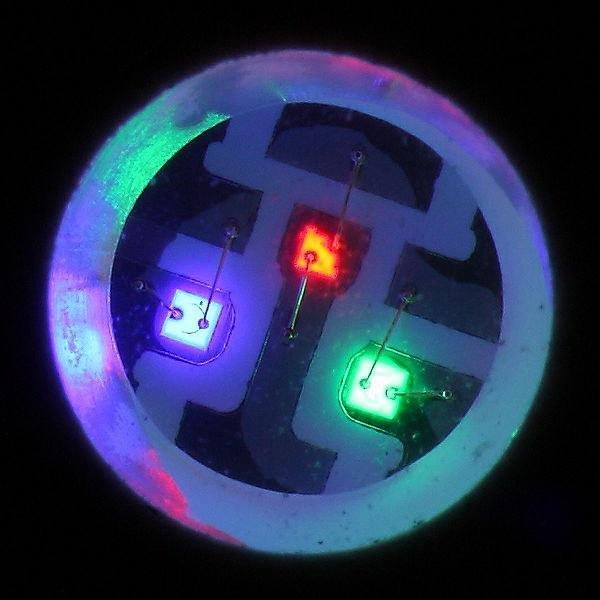
In 1996, the first white phosphor LEDs appeared. In them, the light of an ultraviolet or blue LED is converted to white using a phosphor.
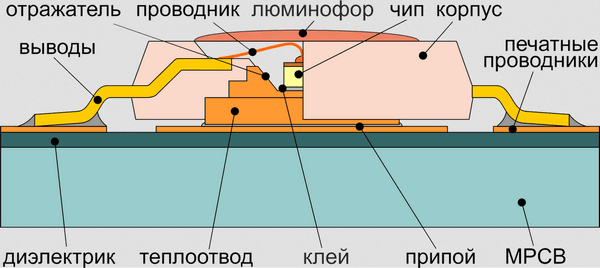
By 2005, the luminous efficiency of such LEDs reached 100 lm / W or more. This made it possible to start using phosphor LEDs for lighting, because LED is one of the most economical light sources.
4. What kinds of LED bulbs are there?
LED lamps are available in various housings with different types plinths. These are ordinary "pears", "candles" and "balls" with E27 and E14 sockets, and "mirror" lamps R39, R50, R63 and soffits with GU10 and GU5.3 sockets, capsule lamps with G4 and G9 sockets, lamps for ceilings with GX53 plinth.
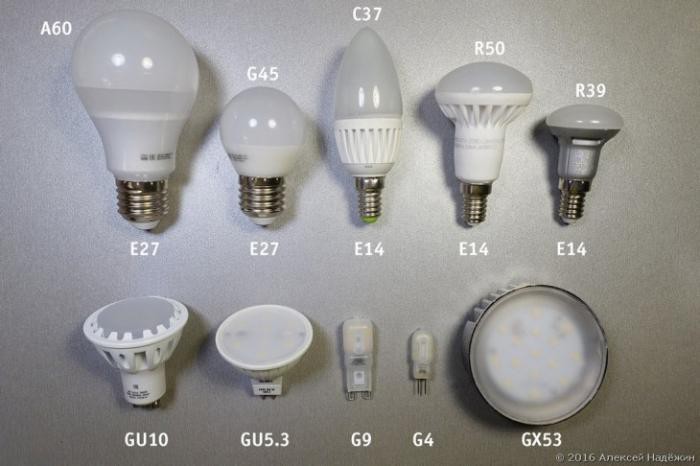
LED bulbs use Various types LEDs. The first LED bulbs used conventional LEDs in a plastic housing.

Now powerful LEDs in housings are used only in some lamps. Most modern lamps use unpackaged LEDs and LED assemblies.

V recent times COB (chip on board) LED emitters are increasingly used. In them, many LEDs are covered with a single phosphor.
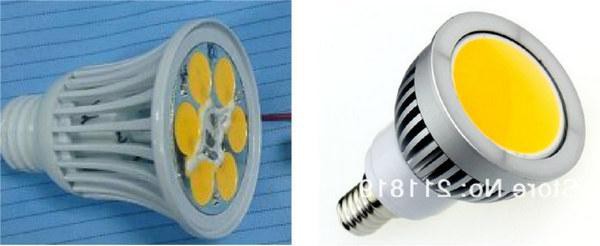
A variation of COB is LED filament. In them, many LEDs are placed on a glass strip coated with a phosphor.
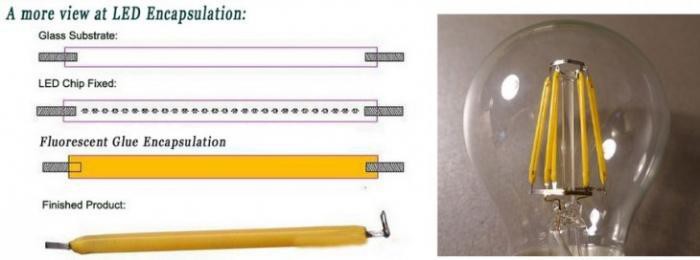
In the latest generation of Crystal Ceramic MCOB lamps, the emitters are located on round transparent ceramic plates.
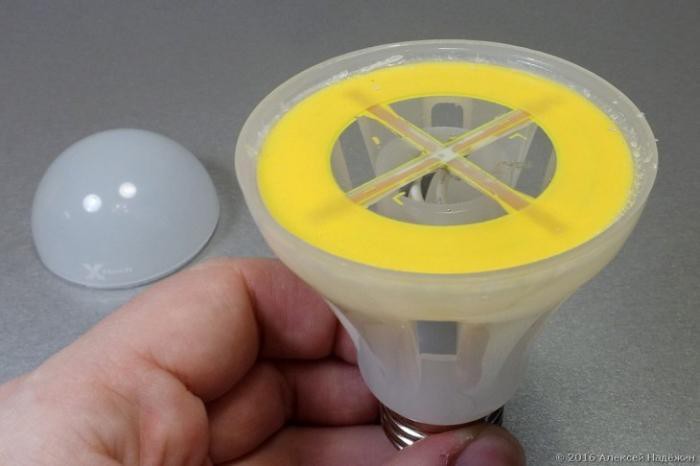
LED lamps are available with different color temperature of light: 2700K - yellow light like incandescent lamps, 3000K - a little more white comfortable light, 4000K - white light, 6500K - cold white light. In my opinion, lamps with a color temperature of 2700-3000K are more suitable for home.
5. Are all LED bulbs good, and if not, how are good ones different from bad ones?
In ordinary incandescent lamps, everything is simple: a bulb and a tungsten filament. The LED lamp is much more complex and its quality depends on the quality of LEDs, phosphor and electronics.
There are three important parameters that affect the quality of light that a lamp gives:
1. Ripple of light ... Many substandard lamps have high level ripple (flicker) of light. Such light is visually uncomfortable and a person quickly gets tired of it. When looking from one object to another, a stroboscopic effect is visible (as if several objects are seen instead of one). The human eye perceives a pulsation of more than 40%. There are two ways to check the presence of light pulsation - pencil test (we take an ordinary long pencil by the tip and begin to quickly and quickly move it in a semicircle back and forth. flickering) and checking with the smartphone camera (if you look at the light through the smartphone camera, as a rule, when the light flickers across the screen, stripes will appear, and the brighter they are, the stronger the flicker). Visible pulsation lamps should not be used in residential areas.
2. Color rendering index (CRI) ... The light spectrum of an LED lamp differs from the spectrum of sunlight and light from a conventional incandescent lamp. Although the light looks white, it has more color components and some fewer. CRI shows how uniform the level of different color components in light is. With a low CRI of light, shades are less visible. Such light is visually unpleasant, and it is very difficult to understand what is wrong in it. For incandescent and sun lamps, CRI = 100, for ordinary LED lamps it is more than 80, for very good lamps it is more than 90. It is better not to use lamps with a CRI below 80 in residential premises.
3. Angle of illumination. LED pear lamps are of two types. In the former, the protective cap has the shape of a hemisphere having the same diameter as the body. Such lamps do not shine back at all and if they shine down in the chandelier, the ceiling will remain dark, which can be visually ugly. In the second type of lamps, the transparent cap has a diameter larger than the body and the lamp shines a little back as well. LED filament or transparent disc bulbs have the same wide illumination angle as conventional incandescent bulbs. Halogen spotlights emit a narrow beam of light with an illumination angle of about 30 degrees, and most LED spotlights shine with diffused light at an angle of about 100 degrees. Such bulbs in the false ceiling are "blind" due to their too wide angle. Only some LED spotlights have lenses and the same narrow illumination angle as halogen lamps.
And three more problems that can often be encountered with LED lamps:
1.
Inconsistency between the luminous flux and the equivalent to the declared values. Unfortunately, often on the packaging of LED lamps, overestimated values of the luminous flux and equivalent are written. You can find lamps on which a luminous flux of 600 lm is indicated and that the lamp replaces a 60-watt incandescent lamp, but in fact it shines only like a 40-watt lamp.
2.
The color temperature does not match the declared one. Very often there are lamps, the color temperature of the light of which differs from what the manufacturer promises. Instead of 2700K, you can find 3100K, and instead of 6000K, even 7200K.
3.
Premature lamp failure. Manufacturers indicate the lifespan of LED lamps from 15,000 to 50,000 hours, in fact, the lamps sometimes break after several months of operation.
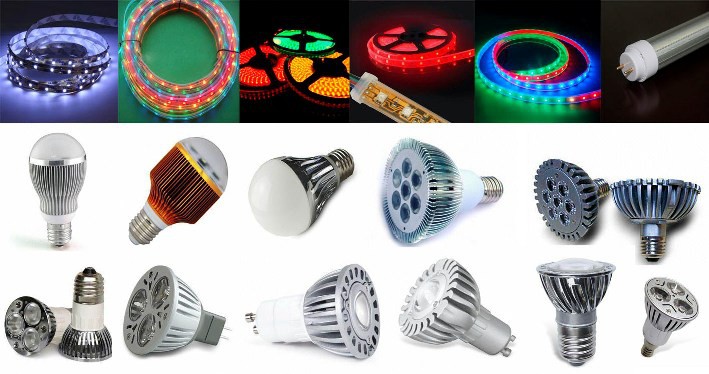
6. How to choose high quality LED bulbs?
On Russian market lamps of several dozen brands are presented. Most of them are Russian brands that manufacture custom-made lamps in China. Many people think that since the lamps are Chinese, it is better and cheaper to buy them in Chinese online stores, but this big mistake... Unfortunately, the vast majority of lamps from Chinese shops are of very poor quality. Their power and luminous flux are much lower than promised, the color rendering index (CRI) is low, many lamps have ripple, sometimes reaching 100%, the color temperature is not standardized (the Chinese often write "warm white light 2700-3500K" and what will happen in fact no one knows), there is no guarantee for such lamps, and if they fail, it will not work to change them. I tested several dozen lamps from Chinese online stores and there was only one good one among them, while it cost more than similar lamps in Russia.
I know of only four brands that do not overestimate the luminous flux and the equivalent on the package. it Ikea, Osram, Philips and Diall, therefore, when buying lamps of all other brands, it is better to take lamps "with a margin". If you need to replace a 40-watt light bulb, it is best to use the one that says "60W incandescent bulb equivalent."
If you have the option to turn on the lamp when purchasing, make sure it doesn't flicker with a pencil test or smartphone. Lamps with unacceptable pulsation come across even brands such as Osram. If the flickering was found already at home, feel free to return the lamp - according to Russian laws, LED lamps can be returned to the store within 14 days from the date of purchase.
Pay attention to the warranty periods (lamp warranties range from one to five years) and keep receipts. Lamps must be exchanged at the point of purchase.
Before our eyes, a real revolution in lighting is taking place: the world is rapidly moving to LEDs. Only five years ago, LED lamps were a technical innovation, now LED lighting is used in all spheres of life: LED lights can be found even in villages, many offices, hotels and public buildings are illuminated LED lamps, the vast majority of concert and theatrical lighting has become LED. LED lamps are also appearing in many apartments, because they have begun to be sold even in grocery stores, and in household goods stores the range of LED lamps already exceeds the range of other types of lamps.
An LED lamp is a rather complex electronic device with several dozen parts, the quality of which determines the quality of light, its safety for health and the durability of the lamp. In this article, I will try to tell everything about household LED lamps: what important lamp parameters you need to pay attention to, how expensive lamps differ from cheap ones, what harmful factors low-quality lamps can have, how manufacturers deceive buyers, what to look for when buying lamps.
Advantages and disadvantages
LED bulbs have many advantages over conventional incandescent bulbs:
Efficiency: with the same amount of light, a modern LED lamp consumes 7-10 times less electricity;
Durability: LED lamp lasts 15-50 times longer than usual;
Slight heating: the child will not be burned by the LED lamp in the table lamp;
Same brightness at different mains voltage: unlike incandescent lamps, LED lamps shine just as brightly at reduced mains voltage;
The ability to install an LED lamp, much brighter than an incandescent lamp, in a luminaire that has a power limitation;
Light good lamps visually indistinguishable from incandescent light.
There are advantages when compared with compact fluorescent (energy-saving) lamps (CFLs):
No hazardous substances (any CFL flask contains mercury);
Economical: the lamp consumes less energy at the same luminous flux;
The LED lamp instantly lights up at full brightness, and the CFL smoothly gains brightness from 20% to 100% per minute at room temperature and much slower at low temperatures;
CFLs have a poor spectrum with multiple peaks. The spectrum of an LED lamp is much closer to natural light and incandescent light.
Of course, there are also disadvantages:
High price;
Market presence of lamps with poor quality light (ripple of light, bad color characteristics, uncomfortable color temperature, discrepancy between the luminous flux and the equivalent of an incandescent lamp as stated);
Problems with some lamps with switches that have an indicator;
Brightness control (dimming) is supported only by special more expensive lamps.
Let's deal with savings
The main advantage of LED lamps is electricity savings. With the same amount of light emitted by the lamp, an LED lamp consumes 7-10 times less electricity than a conventional incandescent lamp. Already, you can buy 6-watt LED pear lamps, and 4-watt candle lamps, which give as much light as a 60-watt and 40-watt incandescent lamp, respectively.
I figured out what the electricity costs would be when lighting a two-room apartment with conventional and LED lamps.

Of course, this is a rough estimate.
Any incandescent lamp has a 1000 hour life on the packaging. If the lamps actually work for 1000 hours (unfortunately, they often burn out much earlier), lamps in the hallway and in the room will have to be changed twice a year, and once in the kitchen and in the bedroom. At a lamp cost of 30 rubles, 690 rubles will be spent on the purchase of new lamps. LED lamps do not have to be changed every six months, because their service life is 15-50 thousand hours. This is from 7 to 22 years old when used for 6 hours a day.
The purchase of lamps for this apartment will cost 4045 rubles (7 E27 6 W lamps for 240 rubles, 11 "candles" 4 W for 215 rubles) and they will pay off in less than a year.
LED and energy saving lamps
LED lamps are undoubtedly energy-efficient, but the word "energy-efficient" has stuck with compact fluorescent lamps (CFLs), and CFLs and LEDs are completely different things.

CFLs went on sale ten years ago and were expected to replace incandescent bulbs. However, CFLs turned out to be a dead-end branch of evolution. These lamps have many disadvantages: the lamp tube contains mercury, the lamp flares up slowly and does not shine at all in the cold, CFLs have a poor spectrum, consisting of peaks of several colors.
From July 1, 2016, in accordance with the Decree of the Government of the Russian Federation No. 898 of 08/28/2015, all state and municipal enterprises and institutions will be prohibited from buying any lamps containing mercury (including CFLs) through the public procurement system. Already, the number of CFLs in stores is constantly decreasing and soon they will disappear altogether.
Let's compare the light spectrum of an incandescent lamp, a fluorescent lamp and an LED lamp.

The spectrum of an LED lamp is much closer to natural light and incandescent light.
A bit of history
For the first time, the glow of a semiconductor junction was discovered in 1923 by the Soviet physicist Oleg Losev. The first LEDs were called "Losev Light" (Losev light). First came the red LED, then yellow and green LEDs appeared in the early 70s. The blue LED was created in 1971 by Yakov Panchechnikov, but it was very expensive. In 1990, Japanese Suji Nakamura created a cheap and bright blue LED.

With the advent of the blue LED, it became possible to make white light sources with three crystals (RGB). Such sources are still used today in concert and decorative lighting.

In 1996, the first white LEDs using a phosphor appeared. In them, the light from a blue or ultraviolet LED is converted to white using a special chemical applied over the light-emitting crystals.

In 2005, the efficiency of such LEDs reached 100 lm / W, which made it possible to start using phosphor LEDs for lighting. Now the most efficient white LEDs already give 200 lm / W, serial lamps with standard plinths- up to 125 lm / W.
Types of LED lamps
LED bulbs repeat everything possible types incandescent, halogen and fluorescent lamps. Ordinary lamps "pears", "candles" and "balls" with E27 and E14 bases, "mirror" lamps R39, R50 with E14 bases, and R63 with E27 bases, spots with GU10 and GU5.3 bases, capsule micro lamps with bases are produced G4 and G9, lamps for ceilings with GX53 base.

Various types of LEDs are used in LED lamps. The earliest LED bulbs used conventional LEDs in a plastic housing. Such lamps are called "Corn" (Corn) for their visual resemblance to the corn on the cob.

Nowadays, LEDs in housings are rarely used in lamps, and, as a rule, they are powerful LEDs.

Most modern lamps use unpackaged LEDs and LED assemblies.
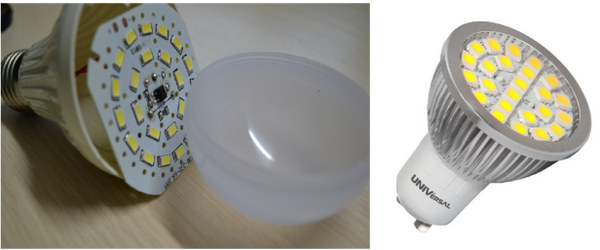
Recently, COB (chip on board) LED emitters are increasingly used. In them, many LEDs are covered with a single phosphor.
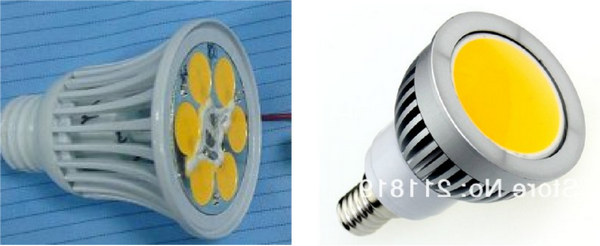
A type of COB is LED filament, in which many LEDs are placed on a metal, glass or sapphire strip coated with a phosphor.

Even appeared Russian word"filament", which some manufacturers began to use.
Another one latest technology- Crystal Ceramic MCOB. There are many LEDs on the transparent ceramic plate. The plate is covered with a phosphor on both sides, so this emitter shines almost evenly in all directions.

Parameters of LED lamps
The light quality of an LED lamp is influenced by five main parameters:
1. Luminous flux. Measured in lumens, (Lm, Lm).
Luminous flux is total amount the light that the lamp gives. The more lumens, the brighter lamp... A 60-watt incandescent lamp gives approximately 580 lm, a 40-watt 350 lm, a 75-watt - 800 lm, a 100-watt - 1250 lm. You will see higher values in standards and on many sites. I provide data for ordinary lamps that are sold in stores, operating on a regular network, which is usually about 220 volts (and not 230, relying on the standard).
2. Coefficient of pulsation of light.
Natural light sources (sun, candle fire) shine evenly, however, many electrical light sources (lamps, monitor screens) do not give uniform light, but pulsating one, while the frequency and degree of pulsation can be very different.
At a frequency of 50 Hz, light pulsation of more than 40% is perceived visually as a stroboscopic effect (pulsation is visible with a sharp translation of the gaze or turn of the head). Such a pulsation is easy to recognize with the help of a pencil test: we take an ordinary long pencil by the tip and begin to quickly and quickly twist it in a semicircle back and forth. If the individual contours of the pencil are not visible, there is no flicker, but if "several pencils" are visible, the light flickers.
The visible pulsation of light causes feelings of discomfort, fatigue and even malaise. In addition, modern medical research shows that the organs of vision and the brain are able to perceive invisible pulsation of light with a frequency of up to 300 Hz. At a high flickering frequency, light does not have a visual effect, but it can affect the hormonal background, which in turn affects a person's emotions, his performance, circadian rhythms, and many other areas of life.
Light with a pulsation frequency above 300 Hz has no noticeable effect on the human body, since pulsations at such frequencies are simply not perceived by the retina.
SNiP 23-05-95 "Natural and artificial lighting" states that the coefficient of pulsations of the illumination of the working surface of the workplace should not exceed 10% - 20% (depending on the degree of work intensity), while only those pulsations are normalized whose frequency is lower 300Hz.
In SanPiN 2.2.2 / 2.4.1340-03 " Hygiene requirements to personal electronic computers and organization of work "it is indicated that the coefficient of pulsation of lighting when working on a PC should not exceed 5%.
According to GOST 54945-2012, the ripple coefficient is determined by the formula:
![]()
Thousands of brightness measurements are made per second. The minimum value is subtracted from the maximum value obtained and the result is divided by two average values (the sum of all values divided by their number), the resulting result is multiplied by 100.
When there is no light ripple, all measured values are the same and the ripple factor is zero.
V modern systems, where the brightness is controlled by PWM, the light pulse can be much shorter than the pause and then the ripple coefficient can take on values greater than 100%.
For example, when a light pulse is 10 times shorter than the pause between pulses, the brightness in the pulse is 100 Lm, the brightness in the pause is 0, the average value will be 10 Lm and according to the formula ((100-0) / (10 * 2)) * 100 = 500%.
Ripple factor of over 100 is found in bad LED bulbs and bad monitors.
Most good LED bulbs have a light ripple rate of less than 5%.
Conventional incandescent lamps have a light ripple factor of 8 to 32%, depending on the power (more precisely, on the thickness and inertia of the spiral), so there is nothing wrong with LED lamps with light pulsation up to 40%, but to buy lamps with a ripple of more than 40% and should not be used under any circumstances.
Another way to check for light pulsation is to look at the light through your smartphone's camera. As a rule, when the light pulsation is more than 5%, stripes will go across the screen, and the more contrast they are, the stronger the pulsation. The disadvantage of this method is that the stripes will be visible even with a harmless ripple of 5-40%.
The light spectrum of an LED lamp differs from the spectrum of sunlight and light from a conventional incandescent lamp. Although the light looks white, it has more color components and some fewer. Color rendering index shows how even the level of different color components in light is. At low Ra, shades are less visible. Such light is visually unpleasant, and it is very difficult to understand what is wrong in it. Incandescent and sun lamps have Ra = 100, good LED lamps have more than 80, very good more than 90. It is better not to use lamps with Ra below 80 in residential premises.
The Ra index takes into account only eight colors and pink, which affects the perception of human skin tones, not among them. Sometimes you can find the indication of the index R9 - this is just a pink color. It is believed that R9 should be greater than zero for good lamps. Very good ones have more than 50.
Recently, two more new systems for determining the quality of color in lighting have appeared. These are CQS (based on 15 colors) and TM30 (based on 99 colors). So far, I have not seen a single serial lamp on the packaging of which one of these new indices is indicated, but when testing lamps on lamptest.ru I indicate all three indices.
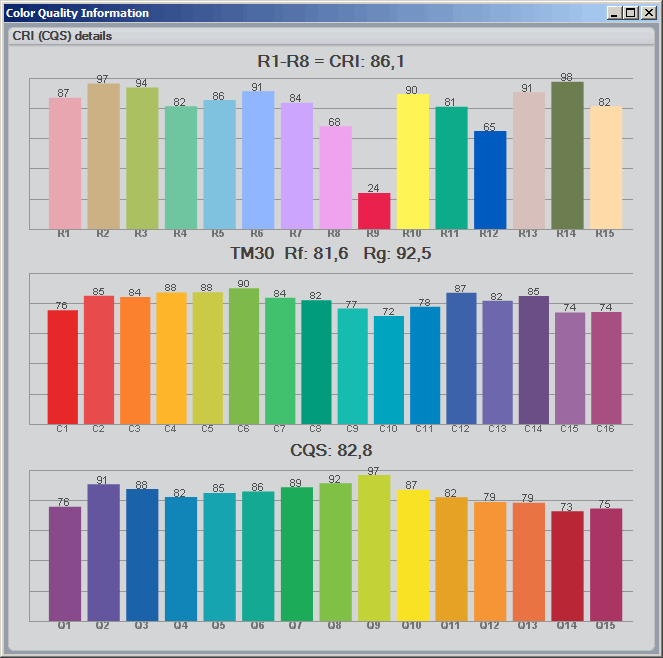
Color Indexes of a Good LED Bulb
4. Colour temperature(measured in degrees Kelvin, K).
LED lamps are available with different color temperatures of light: 2700K - warm light, like incandescent lamps, 3000K - slightly more comfortable white light, 4000K - white light, 6500K - cold white light.
Scientists claim that white and cold white light enhance performance, while warm light promotes relaxation. In order for a person to fully rest at home, coming home from work and falling asleep better, it is recommended to use warm lighting at home. In my opinion, lamps with a color temperature of 2700-3000K are more suitable for home. In addition, LED lamps with warm light the spectrum is smoother, and "cold" lamps have a sharp blue peak on the spectrum, which some scientists believe is harmful to the eyes.
5. Angle of illumination.
Conventional incandescent lamps shine in all directions, halogen spots provide a narrow beam of light. With LED lamps, everything is more complicated.
Many LED bulbs that replace conventional incandescent bulbs have a hemispherical dome of the same diameter as the body. Such lamps practically do not shine backward and if they are directed downward, the ceiling will remain dark, which can be uncomfortable. Fortunately, recently, many lamps have appeared, the transparent cap of which is larger than the body and due to this, the lamp shines a little back too.

Narrow and wide angle lamps
Filament or Crystal Ceramic MCOB lamps have the same wide illumination angle as conventional incandescent lamps.
![]()
Incandescent lamp, filament lamp and Crystal Ceramic MCOB lamp
Most LED spots (lamps for false ceilings with GU10 and GU5.3 bases) shine with diffused light with an angle of about 100 degrees and are dazzled due to a too wide angle (halogen spots give a narrow beam of light with an illumination angle of about 30 degrees).
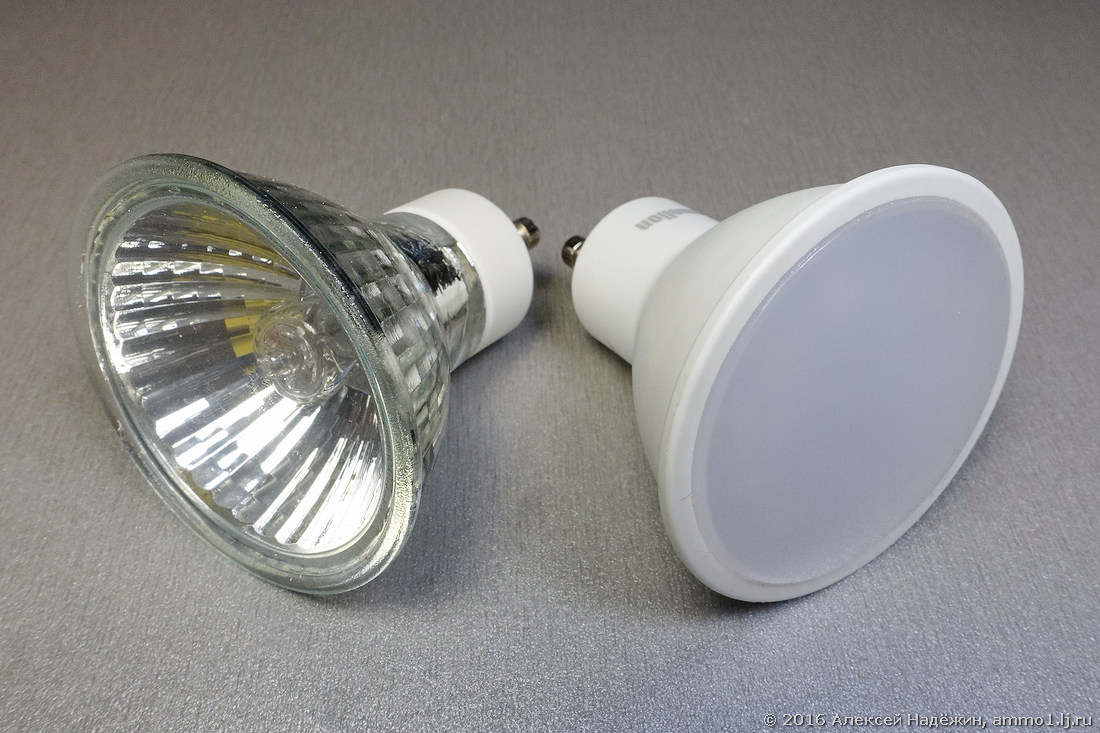
Halogen lamp and LED lamp with wide illumination angle
Only a few LED spots have the same narrow illumination angle as halogen bulbs. These lamps are easily recognizable by the presence of lenses in front of the LEDs.
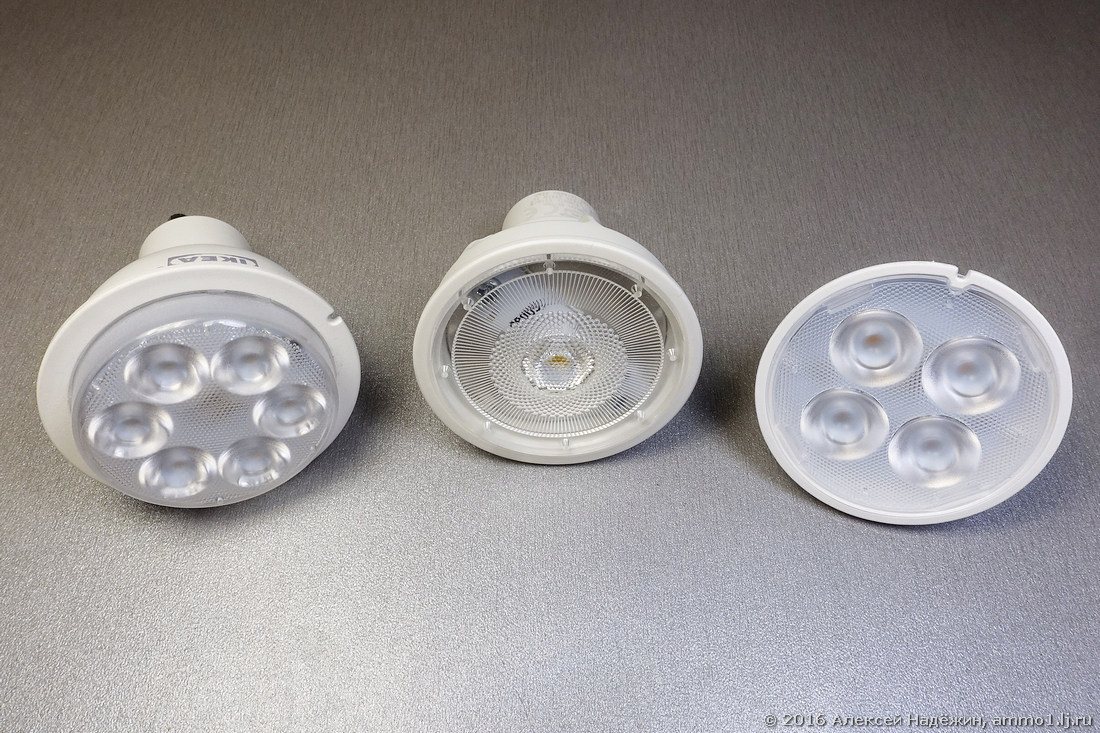
Narrow Angle LED Bulbs
In addition to the main parameters affecting the quality of light, it is important to pay attention to other parameters of LED lamps:
1. Working voltage.
Most LED lamps are rated for 230 V mains voltage, GU5.3 and G4 lamps are also available for 12 volts. LED bulbs work in wide range stress. Usually, manufacturers indicate the range accurately (for example, 90-265 V), but even those lamps whose packaging says 230, 220 or 220-240 V can work normally at very low voltages without reducing brightness.
All 12-volt lamps can operate on both AC and DC voltage. The use of a stabilized constant voltage source allows you to completely eliminate the ripple of light even in those 12-volt lamps that flicker when powered by alternating voltage.
2. Power consumption.
LED bulbs are very economical. Typically, the power of the lamps is in the range of 1.5-15 watts. The brightness of LED lamps cannot be judged by power: the more modern the lamp, the brighter it shines at the same power. The efficiency of commercially available LED lamps ranges from 40 to 125 lm / W, so the brightness of a lamp with the same wattage may differ by a factor of three.
3. Support for work with a switch with an indicator.
Many LED lamps cannot work with switches that have an indicator. They flash or light dimly when the switch is off. This is due to the fact that a weak current is constantly flowing through the lamp. There are two ways out of this situation: either use lamps that work correctly with such switches or turn off the indicator inside the switch.
4. Support for dimming.
Most LED bulbs cannot work with dimmers (dimmers), but there are special dimmable LED bulbs (they are more expensive than conventional ones). Unlike incandescent lamps, when the brightness decreases, the LED lamp does not change the color of the illumination (it turns yellow in a conventional lamp). Many dimmable LED bulbs are not dimmable to zero, but only to 15-20% full brightness. The minimum dimming level depends not only on the lamp, but also on the dimmer model. As a rule, those dimmers that are specifically designed for LED lamps allow you to set a lower minimum brightness.
Some LED lamps, when working with a dimmer, emit a humming sound, the volume of which may also depend on the dimmer model.
5. Equivalent power.
Most manufacturers indicate on the packaging of lamps the equivalent of the power of an incandescent lamp, that is, which incandescent lamp corresponds to the brightness of the lamp. In Europe, there is a correct tendency to refuse to indicate the equivalent - buyers are taught to choose lamps by brightness and lumens. Most LED lamps in European stores now have large luminous flux and no power equivalents.
6. Power Factor.
Most LED lamps consume current unevenly during the sinusoidal period of the supply voltage. For household use, it has no of great importance, since all household meters only take into account active power, which is indicated in the characteristics of the lamps. The PF value for LED lamps can be from 0.2 to 1.
7. Overall dimensions.
When choosing lamps, do not forget to pay attention to the overall dimensions, which are sometimes much larger for LED lamps than for corresponding incandescent lamps. The lamp may simply not fit into the lamp or it will be ugly sticking out of the shade.
8. Service life.
Manufacturers indicate a lifespan of 10,000 to 50,000 hours for LED lamps. It is important to understand that all these terms are calculated theoretically and it is impossible to verify this in practice - lamps have been produced not so long ago, and 50,000 hours is almost six years of continuous operation.
9. Warranty period.
Manufacturers give a guarantee for lamps for a period of 1 to 5 years. I recommend that you always take photos of receipts with your smartphone when you buy lamps. The check will be lost or fade, but the photo will remain and it will be possible to restore the check and exchange the lamp. Any store selling lamps is obliged to exchange them under warranty, if the store is gone, feel free to contact the manufacturer. The lamp warranty works!
10. Reliability of lamps.
Unfortunately, not all LED lamps work those tens of thousands of hours that the manufacturer promises. Of the 14 LED lamps installed in my apartment, 4 failed in three years, and only one of them - after the end warranty period... I repeat again - change the lamps under warranty if they break.
11. Date of manufacture of the lamp.
No, lamps do not deteriorate from long storage, but technology is developing very quickly and lamps that were released two years ago are likely to be worse than those that were produced more recently. Pay attention to the date of manufacture (if any) when purchasing lamps. I do not recommend buying lamps that were produced more than a year ago.
What manufacturers save on
On sale you can find almost the same lamps at a price that differs several times. So what do manufacturers save on and is it possible to buy cheap lamps?
1. LEDs and phosphor.
Low CRI LEDs are often used in cheap lamps. Fortunately, there are almost no lamps left with Ra less than 70 on sale, but with Ra 72-75 they are sold a lot, although it is believed that for household lighting Ra must be at least 80.
2. Electronics.
In cheap lamps, instead of a full-fledged driver board, it is often used the simplest scheme from diode bridge and two capacitors. Such lamps almost always have an unacceptable pulsation of light and dimly glow when connected through an off switch with an indicator.
Unscrupulous manufacturers use cheap capacitors to reduce the cost, which rarely work for more than 2-3 years.
3. Cooling.
Cheap lamps use the most primitive heat sinks. LEDs and elements electronic circuit may overheat and the lamp will fail much earlier.
How manufacturers cheat buyers
Many manufacturers indicate inflated parameters on the packaging of lamps. You can find lamps that say "Equivalent to 60 W incandescent lamp", but they shine only like 25-watt incandescent lamps.
Here is an incomplete list of manufacturers' tweaks:
1. Overpriced equivalent.
The manufacturer indicates the equivalent of an incandescent lamp is much higher than the real one. Sometimes the manufacturer can be caught without even opening the lamp packaging. I have come across lamps on which the equivalent of 60 W was indicated, and in small letters the luminous flux of 340 lm, corresponding to a power of 40 W.
2. Excessive luminous flux.
© 2016, Alexey Nadyozhin
The main topic of my blog is technology in human life. I write reviews, share experiences, talk about all sorts of interesting things. I also do reports from interesting places and talk about interesting events.
Add me to your friend list




